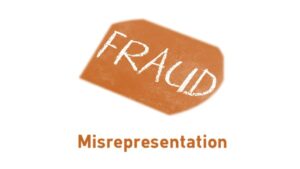Table of Contents
INTRODUCTION
The difference between fraud and misrepresentation is that fraud happens when a person or a party intentionally and willfully represents false information to deceive another party. In contrast, misrepresentation occurs when a person or a party unintentionally gives incorrect information to another party.
FRAUD
A false representation willfully made by a party to a contract in order to mislead the other party and induce him to enter into the contract is known as fraud.
The party making the false representation has made it either knowingly or negligently just to deceive the other party. The aggrieved party, relied on the statement, believing it to be true, and acted upon it, which became a cause of loss to the aggrieved party. In addition to this, the representation of the fact must be made before the conclusion of the contract. Concealment of a material fact in a contract also amounts to fraud, but mere silence does not amount to fraud except where the silence is equivalent to speech or where it is the duty of the person making the statement to speak.
Now the contract is voidable at the option of the aggrieved party, i.e., he has the right to perform or terminate the contract. Apart from that, any damages suffered by the injured party can also be claimed as well as he can sue the other party in court.
Example: A buys goods worth Rs. 3000 from B, a shopkeeper. A informs B that he will shortly pay the amount of the goods, as he cannot do so because of some financial difficulties. B believes it and allows A to purchase the goods on credit. A, on the other hand, has no intention of repaying B. This type of activity is then considered fraud.
Misrepresentation
Misrepresentation can be defined as an unintentional act of providing false information to the other party.
Misrepresentation happens when a party who believes a fact or information to be true conveys the same information to another party without ulterior motives. The other party relies on the statement or information and enters into the contract. But, later, it was found that the passed-on or conveyed information was false.
It is important to remember that in misrepresentation, both parties are unaware that the information is false and enter into a contract assuming that the information is true. Let’s go through an example to understand the term “misrepresentation” in a better way.
Example: C says to D to purchase his car which is in a good condition, D purchased it in good faith but after a few days, the car did not function properly and D has to suffer a loss to repair the car. So the act amounts to misrepresentation as C believes that the car works properly but this is not so.

Differences between fraud and misrepresentation
| FRAUD | MISREPRESENTATION |
| Section 2 (17) of the Indian Contract Act, 1872 | Section 2 (18) of the Indian Contract Act, 1872 |
| The purpose of fraud is to deceive the other party. | The purpose of misrepresentation is not to deceive the other party |
| In the event of fraud, the harmed party may sue for damages | In the case of misrepresentation, however, the harmed party cannot sue for damages. |
| In fraud, the party making the representation is aware of the truth | In misrepresentation, the party making the representation is unaware of the truth. |
| Fraud can be defined as the deliberate and willful representation of false information in order to deceive the other party and make them enter into a contract. | Misrepresentation can be defined as an unintentional act of providing false information. |
| The contract is voidable even if the truth can be discovered in normal diligence. | The contract is not voidable if the truth can be discovered in normal diligence. |
